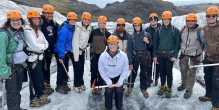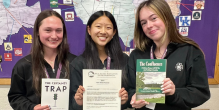STEM Opportunities for all Students
Reprinted from Traditions, Winter 2020-21
June 9, 2021
Steph Aumann has been a teacher at CDH for 24 years. She has dedicated herself to bringing college-level courses to the Science department, helping our students to achieve their academic goals. She was a soccer coach for 16 years, and has traveled the globe on Justice Education Trips with our students. Currently, she teaches Advanced Physics and Physics by Inquiry.
What made you decide to be an educator?
I actually started in engineering, but after a few years of college I realized I wanted to work with people and not things. So, I changed majors. When I had to do some teacher prep hours for one of my classes, my advisor placed me in a really tough middle school in East Aurora, IL. He told me I would either sink or swim. I fell in love with it and it was really tough to leave those kids!
What is your favorite lab or experiment to run each year?
I do a projectile lab where students tie a ball onto a string and then it swings and becomes a free-flying object. They have to hit a target that they have placed on the ground. They do calculations to calculate where they place this target. The math application and the fact that they can hit right in the center of the target through proper measurements and calculations is really amazing and fun for the students to see.
Why have you made the effort to bring more college-credit courses to CDH?
I wanted to make college credit courses available to students who are not on the AP track. The Physics by Inquiry class I teach is meant for non-science majors to get their college science credits out of the way. The Advanced Physics class is considered a traditional Intro to College Physics class.
The value in this is that I can help them to get through a challenging college-level class. This opens up their college schedule to take courses towards their major. The other benefit is that going into college with credits under their belt helps them with registering before others with no college credit, so they can get the courses they need on their schedule.
What have you changed about your teaching this year that you will carry forward once we are back to a normal routine?
I will carry forward all the new materials that I have had to create for students that are at home while others are doing a lab. I have learned a lot of new technologies in hopes of sparking some interest in my students, instead of just asking students at home to do worksheets when the students in class are doing a lab.
COVID-19 has definitely changed my teaching. On lab days, the group that is on Zoom is doing a different assignment at home while the kids in lab are doing the lab. The total distance learners are then placed in a breakout room with someone that is doing the lab and watching/doing from home.
Having three different types of learners at the same time is very challenging and I often go home exhausted and wondering if I did enough and wondering how I can do it better.
How has the increased focus on STEM changed your teaching?
I have always tried to incorporate and apply hands-on activities and real-life scenarios into my teaching so the increased emphasis has just reinforced that what I am trying to do is the right way to go.
What are the benefits of STEM education in high school for students who don't pursue these fields further?
This type of education works on problem-solving and being creative to solve a problem. These are huge life skills that any student will take with them no matter what career they pursue. Physics is a tough subject but it is really amazing when you look at all the real-world applications how much these kids can apply it to their worlds.
Subscribe to our e-Newsletters
You might also like:
Students Gain Hands-On Earth Science Experience on Iceland STEM Trip
This June, a group of CDH students went on a STEM trip to Iceland, traveling between volcanoes, glaciers, waterfalls, and geysers to learn about earth and environmental science in one of the world’s most unique geographical regions.
Beyond the Books - June 2025
The latest news from Athletics, Band, Choir, JROTC and Theater.
CDH Juniors Honored with Prestigious Book Awards
Emma Kennefick '26, Annie Fielder '26, and Cecilia Larson '26 received this year’s Harvard, Yale, and Dartmouth Book Awards for their academic excellence, leadership, and character.




